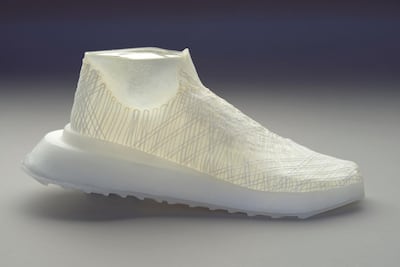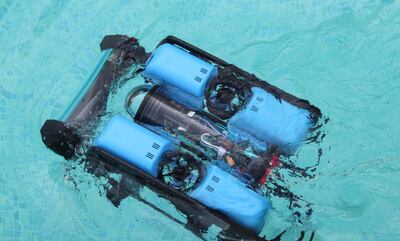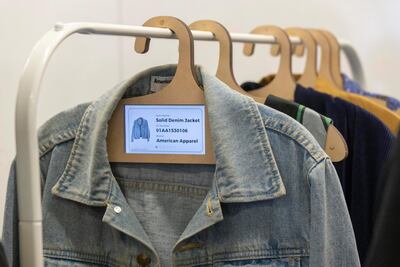A kettle for the blind; furniture made from fungi; a pen that detects cancer; and the world's first violin crafted from silk. You'd be hard-pressed to find a more diverse collection of ideas and products than those currently being presented as part of Dubai Design Week's Global Grad Show at D3.
A total of 150 projects by graduates from more than 100 universities around the world – including Harvard, Massachusetts Institute of Technology and Royal College of Art – are presenting far-reaching and potentially life-changing inventions that address some of the most pressing issues of our time. On a macro level, these innovations tackle climate change, look at how access to clean water can be improved around the world, address personal safety in cities, and suggest new ways of exploring our oceans. And on a micro level, they look at how living environments can be enhanced and personal health can be monitored and improved.
And if this glimpse into the future were not enough, running alongside the Global Grad Show is a conference called Belief in AI, where experts in the fields of automation, urban development, infrastructure, transport and aviation have gathered to ponder on the positives, pitfalls and potential interpretations of artificial intelligence.
We take a look at some of the projects on show that could make the world a better place.
1. Let there be light
Like something from a sci-fi film, Twinkle is a futuristic proposal for individualised urban lighting. The solution by Honghao Deng and Jiabao Li of Harvard University responds to the deficiencies of current street-light systems, which leave many urban neighbourhoods feeling poorly lit and, by extension, unsafe. Inspired by fireflies, Twinkle is a population of luminous robots that “live” on lamp posts. During the day, they are at rest, happily recharging themselves through their solar wings. At night, they act as trusty companions, bathing pedestrians in a circle of personalised light as they make their way through darkened streets. “They are designed to provide a playful, non-threatening presence that reassures pedestrians and adds life to even the most poorly lit area,” say Twinkle’s creators.
2. Fancy footwear
Sustainable footwear is a recurring theme at this year's Global Grad Show. This is Grown by Jen Keane of Central Saint Martins proposes a shoe partly made from bacteria, merging modern textile design with biotech principles that manipulate the growing process of K. rhaeticus bacteria, to create a new form of microbial weaving. Algikicks shoes, meanwhile, are made from a rapidly renewable kelp-based material, which will degrade at the end of the product's lifespan – offering a sustainable alternative to trainers, which can take up to 1,000 years to decompose. Slightly less stylish, but no less worthy, are the Sho shoes, which can be easily disassembled, making them much easier to recycle, and for parts that are broken or worn down to be replaced.
3. Healthy treats
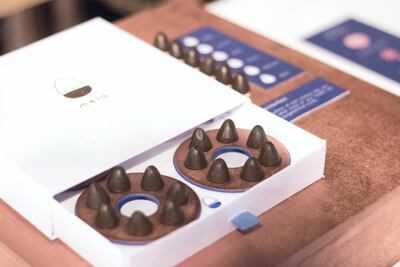
Mela, by Maria Apud Bell from RCA, proposes chocolates that contain good bacteria that are specifically designed to optimise your health. Your bacterial needs can be monitored with a Gutbot – an electronic pill that measures your microbiota from inside your body. Users can respond by adjusting their bacterial levels, potentially reducing the impact of stress, improving sleep cycles, controlling sugar and lipid metabolism, and reducing the painful symptoms of digestive problems. A dedicated app will help monitor progress.
4. Sea change
The ReefRover recognises the need for us to pay closer attention to our ocean environments. A submersible drone that autonomously scans marine environments, the device is a way of enabling researchers and non-professional explorers to gather high-quality image data about coral reefs and other underwater environments. Once in the water, the rover, a project by Kyler Meehan of New York University Abu Dhabi, will navigate a grid pattern within a geo-fenced perimeter at a fixed distance above the seabed, capturing high-resolution images. A single ReefRover can cover up to 1,400 square metres per outing, compared to only 100 square metres using other methods.
______________________
Read more:
Your guide to Dubai Design Week: 10 things to do, try, see and eat
Here's what to expect from the first ever Fikra Design Biennial in Sharjah
Bright ideas and lightbulb moments likely at Dubai Design Week
______________________
5. Fast-track diagnosis
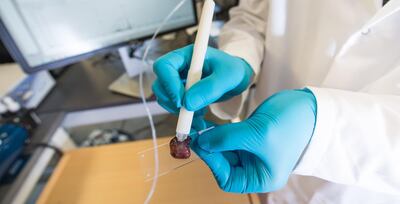
Designed by Livia Eberlin at the University of Texas, the MasSpec pen is a handheld device that allows medical professionals to quickly identify cancer cells. Currently, the process for determining whether tissue is cancerous or not during surgery involves removing a sample from the the patient and examining it under a microscope. This process can take more than 30 minutes, during which time the patient faces increased risk of infection. By contrast, the MasSpec pen requires only 10 seconds. When it comes into contact with potentially cancerous tissue, the pen releases a tiny droplet of water. Chemicals inside the living cells move into the droplet, which is then sucked back up into the pen for analysis. The pen is plugged into a mass spectrometer, which produces a chemical fingerprint that tells doctors everything they need to know.
6. Survival jacket

When disaster strikes, the Tardigrade jacket becomes a life-saver. The garment features a series of straps and contact points that allow it to be fashioned into a shelter or carrying system, or to be reconfigured in countless other ways. Detachable pockets can be used as containers for collecting water or for storing items. The garment is the brainchild of David Bursell, from Lund University, who is concerned with climate change and the natural and social crises that come in its wake. "Tardigrade offers a simple, small-scale solution to problems that endanger everyone."
7. Garment tracking
In an age of mass consumption and ever faster fashion, Loom invites us to think about where our clothes come from. The project by the Hong Kong Polytechnic University proposes a commercial ecosystem that includes a smart label with an NFC chip sticker, an in-shop experience that uses a smart hanger with NFC reader and a mobile app. Together, these elements allows a garment’s owners to read about its history and add to its story. The smart hanger makes this history instantly visible to shoppers. The aim is to encourage mindful consumption and reuse of clothing, by imbuing individual items with a tangible sense of history.
8. Desert growing
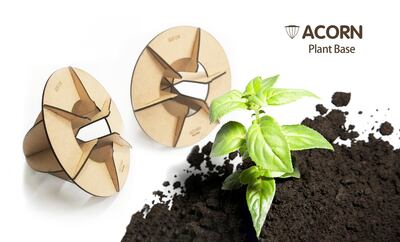
A project with particular resonance in these arid environs is Acorn, a biodegradable base that helps plants to root and improves the quality of desert soil. Raw materials from crop waste are collected and then compressed into boards that are completely biodegradable, which are used to create the "acorns". Plants are put into the soil with their Acorn base, and water is added to keep the base moist. The roots grow within the base and absorb nutrients from it, and the soil is also infused with minerals and nutrients as the base decomposes. After four months of growth, the Acorn will have entirely decomposed, leaving the plant well-nourished and strongly rooted in the ground.


